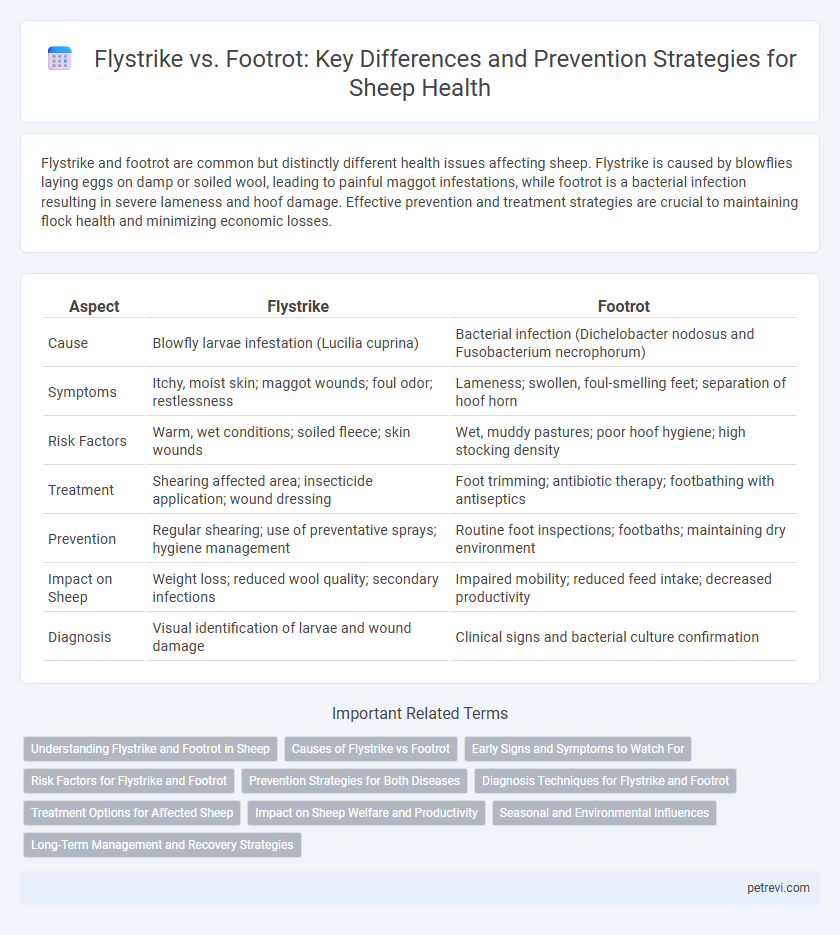Flystrike and footrot are common but distinctly different health issues affecting sheep. Flystrike is caused by blowflies laying eggs on damp or soiled wool, leading to painful maggot infestations, while footrot is a bacterial infection resulting in severe lameness and hoof damage. Effective prevention and treatment strategies are crucial to maintaining flock health and minimizing economic losses.
Table of Comparison
| Aspect | Flystrike | Footrot |
|---|---|---|
| Cause | Blowfly larvae infestation (Lucilia cuprina) | Bacterial infection (Dichelobacter nodosus and Fusobacterium necrophorum) |
| Symptoms | Itchy, moist skin; maggot wounds; foul odor; restlessness | Lameness; swollen, foul-smelling feet; separation of hoof horn |
| Risk Factors | Warm, wet conditions; soiled fleece; skin wounds | Wet, muddy pastures; poor hoof hygiene; high stocking density |
| Treatment | Shearing affected area; insecticide application; wound dressing | Foot trimming; antibiotic therapy; footbathing with antiseptics |
| Prevention | Regular shearing; use of preventative sprays; hygiene management | Routine foot inspections; footbaths; maintaining dry environment |
| Impact on Sheep | Weight loss; reduced wool quality; secondary infections | Impaired mobility; reduced feed intake; decreased productivity |
| Diagnosis | Visual identification of larvae and wound damage | Clinical signs and bacterial culture confirmation |
Understanding Flystrike and Footrot in Sheep
Flystrike in sheep, caused by blowfly larvae infestation, leads to severe skin damage and secondary infections, posing a critical welfare concern. Footrot, a contagious bacterial disease primarily from Dichelobacter nodosus, causes painful lameness and hoof decay, significantly impacting flock productivity. Effective management includes regular monitoring, hygiene practices, and timely treatment with insecticides for flystrike and antibiotics or footbaths for footrot control.
Causes of Flystrike vs Footrot
Flystrike in sheep is caused by the infestation of blowfly larvae that lay eggs in damp or soiled wool, leading to tissue damage as the maggots feed on the sheep's skin. Footrot results from a bacterial infection primarily caused by Dichelobacter nodosus and Fusobacterium necrophorum, thriving in wet, muddy conditions that damage hoof tissue. Both conditions are influenced by environmental factors like moisture and hygiene but differ fundamentally in their biological origins--parasitic larvae versus bacterial pathogens.
Early Signs and Symptoms to Watch For
Flystrike in sheep presents with early signs such as restlessness, wool discoloration, and foul odor around damp or damaged skin areas, often accompanied by maggot presence. Footrot typically shows symptoms including lameness, swelling between the toes, and a sour smell from the infected hoof, causing the animal to hesitate while walking. Monitoring these distinct symptoms enables timely intervention and effective treatment, reducing the risk of severe health complications in sheep.
Risk Factors for Flystrike and Footrot
Flystrike in sheep primarily occurs due to wool contamination with urine or feces, skin wounds, and damp environmental conditions, creating an ideal breeding ground for blowflies. Footrot risk factors include persistently wet pastures, poor hoof hygiene, and the presence of the bacterium Dichelobacter nodosus, which thrives in muddy, warm climates. Both conditions are exacerbated by overcrowding and poor flock management, increasing the susceptibility of affected sheep to infections and weakened immune responses.
Prevention Strategies for Both Diseases
Effective prevention strategies for flystrike and footrot in sheep include maintaining proper hygiene through regular shearing, crutching, and promptly treating wounds to minimize flystrike risk. For footrot, ensuring dry, well-drained pasture conditions and using footbaths with zinc sulfate or formalin help reduce bacterial infections. Vaccination programs combined with quarantine measures for new or affected animals enhance overall flock health and disease control.
Diagnosis Techniques for Flystrike and Footrot
Flystrike diagnosis relies on visual inspection for maggot infestation and tissue damage, often using close examination of the fleece and skin for odor and discoloration. Footrot diagnosis involves assessing lameness, inspecting the interdigital skin for lesions, and sometimes bacterial culture to identify Dichelobacter nodosus. Advanced techniques such as PCR tests enhance accuracy for footrot by detecting specific pathogens, improving differentiation between similar foot conditions.
Treatment Options for Affected Sheep
Flystrike treatment in sheep involves promptly shearing the affected area, cleansing wounds with antiseptics, and applying insecticides or fly-repellent dressings to prevent further maggot infestation. Footrot interventions require thorough hoof trimming, regular application of topical antibiotics or antiseptics, and in severe cases, systemic antibiotic administration to combat bacterial infection and promote healing. Consistent monitoring and environmental management are essential to reduce recurrence and ensure effective recovery from both flystrike and footrot conditions.
Impact on Sheep Welfare and Productivity
Flystrike and footrot significantly impair sheep welfare and productivity by causing severe pain, distress, and reduced mobility. Flystrike leads to tissue damage and potential secondary infections due to maggot infestation, while footrot results in chronic lameness and weight loss from bacterial infection of the hooves. Both conditions decrease feed intake and wool quality, ultimately lowering lamb growth rates and overall flock profitability.
Seasonal and Environmental Influences
Flystrike in sheep is most prevalent during warm, humid months when flies are abundant, often triggered by wet fleece and poor hygiene. Footrot primarily occurs in moist, muddy conditions, especially during rainy seasons, where bacterial infections thrive in the hooves. Seasonal rainfall and pasture management significantly influence the incidence rates of both flystrike and footrot, requiring targeted preventive measures during vulnerable periods.
Long-Term Management and Recovery Strategies
Flystrike and footrot are critical sheep health issues requiring distinct but integrated long-term management strategies to ensure flock productivity. Persistent flystrike control demands regular shearing, timely application of insecticides, and maintaining dry, clean fleece to interrupt the blowfly lifecycle. Footrot recovery hinges on early diagnosis, foot trimming, antibiotic treatment, and implementing strict biosecurity measures to minimize infection spread and promote rapid healing.
Flystrike vs Footrot for Sheep Health Issues Infographic

 petrevi.com
petrevi.com